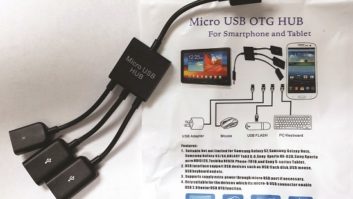Mark Voris, director of engineering for KVSS(FM) and Spirit Catholic Radio in Omaha, Neb., was one of the first Tieline customers to purchase the company’s iPhone Report-IT application and Mic Adapter, which holds the phone and adapts it to an XLR microphone input and headphone jacks.
When many of his staff began upgrading to the iPhone 5 and 6, Mark had a problem: The physical dimensions of the newer phones were different, and the phones wouldn’t fit into the adapter cradle.


Fig. 1: Tieline’s Mic Adapter for the iPhone 4. Notice that the larger phone won’t fit.Fig. 2: The Mic Adapter with its metal extension bracket is viewed from above.
Mark set to work adapting his Mic Adapter. After careful measurement, he sawed through the heavy plastic cradle, drilling the two pieces to accept a new metal bracket that was screwed in place. Fig. 2 shows the top of the modified Mic Adapter and Fig. 3 shows underneath, with the bolts and nuts securing the extension bracket He then purchased a Lightning to 30-pin adapter, as seen in Fig. 4.


Fig. 3: Here’s the back view of the same modified cradle.Fig. 4: A Lightning-to-30 pin adapter plug is also needed for the newer iPhones.
Fig. 5 shows the completed project, with the iPhone inserted.
Mark added a few other features; he uses headphone jacks with spring strain reliefs and has put a color-coded dot by the headphone jack, shown in Fig. 6. This way, staff members don’t have to guess which plugs go where.
Since many Report-IT events involve multiple guests, Mark added a small Behringer headphone amplifier, so everyone can have his or her own headphone volume control, seen in Fig. 7.



Fig. 5: The completed Mic Adapter has been modified for the larger iPhone.Fig. 6: The headphone jack is marked with a colored dot, and a spring strain relief plug is used.Fig. 7: The Behringer HA400 gives each guest position its own headphone adjustment.
***
Roberta X posted an online comment on the Sept. 23 edition of Workbench, with regard to Simpson 260s and Triplett 630 VOMs (Volt-Ohm meters).
These instruments are widely available on the used markets from sources such as eBay, hamfests and surplus outlets.
Roberta says they are worth their weight in gold when you need a dependable reading in adverse circumstances. Even smaller, cheaper oldies such as Triplett’s 666R were popular with many field service groups.
When the engineering crew at Roberta’s station wiped out its last 260 (remember, don’t leave tools on top of stepladders!), $30 at a hamfest got them a clean, recently calibrated analog VOM.
****
Projects and contract engineer Art Reis tells us that a client needed to dispose of some old mercury vapor tubes. Almost all town dumps or refuse depots hold scheduled hazardous waste days, when individuals can bring in hazardous waste items for disposal. This is done once or twice a year, usually at no charge to the individual.
Commercial entities may need to locate a paid vendor to dispose of hazardous waste.
Art lives in Illinois, where the state EPA offers help. There’s info at www.epa.illinois.gov/topics/waste-management/waste-disposal.
If you live elsewhere in the U.S., here’s a link to an EPA resource list for specific information for your locale: http://tinyurl.com/RW-waste.
Art opted to contact Chicago Crime Scene Disposal Co. The situation really came out in his favor. The company’s lead disposal expert lives in Art’s town and works for the local fire protection district. He found a disposal site down south that will accept the rectifier tubes.
Contribute to Workbench. You will help your fellow engineers and qualify for SBE recertification credit. Send Workbench tips to [email protected]. Fax to (603) 472-4944.
Author John Bisset has spent 46 years in the broadcasting industry and is still learning. He handles West Coast sales for the Telos Alliance. He is SBE certified and a past recipient of the SBE’s Educator of the Year Award.












